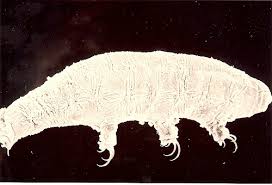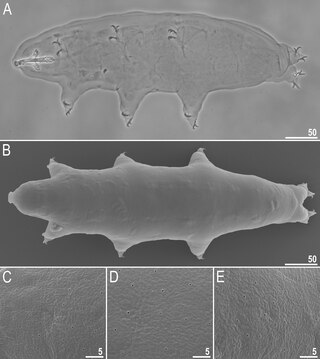
Hypsibius is a genus of tardigrades in the class Eutardigrada.
Diphascon is a genus of water bear or moss piglet, a tardigrade in the class Eutardigrada.

Doryphoribius is a genus of water bear or moss piglet, a tardigrade in the class Eutardigrada.

Ramazzottius is a genus of water bear or moss piglet, a tardigrade in the class Eutardigrada.
Mixibius is a genus of water bear or moss piglet, a tardigrade in the class Eutardigrada.
Parascon is a genus of water bear or moss piglet, a tardigrade in the class Eutardigrada.

Itaquascon is a genus of tardigrade in the class Eutardigrada.
Eremobiotus is a genus of tardigrade in the class Eutardigrada.

Milnesium is a genus of tardigrades. It is rather common, being found in a wide variety of habitats across the world. It has a fossil record extending back to the Cretaceous, the oldest species found so far is known from Turonian stage deposits on the east coast of the United States. Milnesiums are one of the most desiccation and radiation-resistant invertebrates on Earth because of their unique ability to transform into a "tun" state and utilize intrinsically disordered proteins when experiencing extreme environments.

Echiniscus is a genus of tardigrades in the family Echiniscidae. The genus was named and described by Karl August Sigismund Schultze in 1840.
Echinscus clavispinosus is a species of tardigrade in the family Echiniscidae. The species is endemic to the Cape Verde Islands and is found only in the island of Santo Antão. The species was first described by Paulo Fontoura, Giovanni Pilato, and Oscar Lisi in 2011.
Pseudechiniscus is a genus of tardigrades in the family Echiniscidae. The genus was named and described by Gustav Thulin in 1911.

Bryodelphax is a genus of tardigrades in the family Echiniscidae. The genus was first described by Gustav Thulin in 1928.
Bryodelphax meronensis is a species of tardigrade in the genus Bryodelphax which belongs to the family Echiniscidae. The species is endemic to Israel and is found in the area of Mount Meron. The species was first described by Giovanni Pilato, Oscar Lisi and Maria Grazia Binda in 2011. The specific name comes from the location where it was discovered.
Echinscus azoricus is a species of tardigrade in the family Echiniscidae. The species is endemic to the Azores Islands. The species was first described by Paulo Fontoura, Giovanni Pilato and Oscar Lisi in 2008.
Macrobiotidae is a family of tardigrade. As of 2023, it consists of the following genera:

Macrobiotus is a genus of tardigrade consisting of about 100 species.
Pseudechiniscus is a species of tardigrade in the family Echiniscidae. The species is endemic to the island of São Tomé in São Tomé and Príncipe. The species was first described by Paulo Fontoura, Giovanni Pilato and Oscar Lisi in 2010.
Calcarobiotus is a genus of tardigrades belonging to the family Macrobiotidae.
Mesobiotus is a genus of tardigrades belonging to the family Macrobiotidae.







